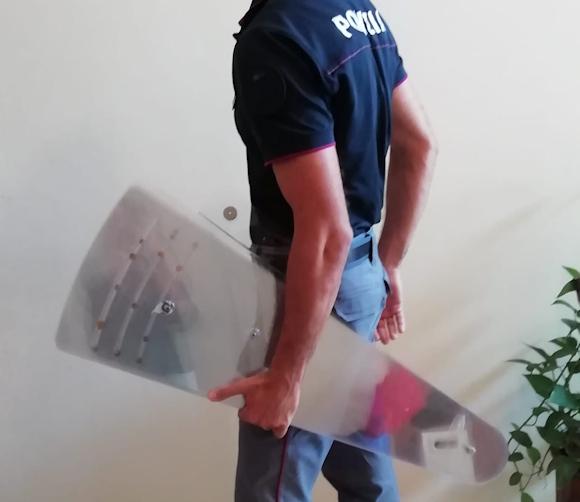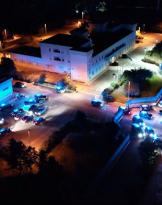One of the most envied Italian characteristics in the world is precisely the ability to create. This primacy is not only the prerogative of stylists, engineers, architects, designers or freelancers but also of many Italians who carry out the most disparate jobs and, among these, even those who work for the State.
One of the battles that this newspaper carries on is the tangible and meritocratic recognition of unknown state servants. If someone has a good idea capable of improving the safety of women and men who work for the community, why not highlight it? In the end then, thanks to the obscure inventors, many will benefit from it.
Were there any noteworthy inventors in the Armed Forces in Italy?
Here are some from the past: Guglielmo Marconi, Regio Esercito (Engineers) and Regia Marina (Commissariat corps), inventor of the wireless telegraph; Enrico Forlanini, Royal Army, engineer officer and inventor of the steam helicopter (1877) and the hydrofoil; Mario Calderara, Regia Marina, officer, designed and built a propeller driven biplane and the first Italian seaplane; Elios Toschi, Regia Marina, naval engineer officer, inventor of the slow-running torpedo; Theseus Tesei, Regia Marina, officer, inventor of the slow-running torpedo; Mauro Picone, mathematician, second lieutenant in artillery during the Great War, calculated the firing tables for heavy artillery; Louis Ferraro, first Regio Esercito and then Regia Marina, inventor of the fins Swallow, diving mask Pinocchio, the regulator with the regulation of the injection and the use of theventuri effect.

Some time ago the case of the Comsubin raider of the Navy was treated who created a special knife for the special forces (read article "The COMSUBIN knife and fighters"). Today is the turn of another servant of the State, even if he is not a member of the FFAA but rather of the State Police (his invention can also be useful to the military).
The superintendent John Rondinone (in the photo, right) created and patented special shields for public order and tested them with the help of a person who for professional reasons requested anonymity and who we will call by the fictitious name of "Frieda".
To understand the scope of the invention, it is advisable to take a step back in time to enter the curious world of shields: since ancient times man has researched and developed defensive systems suited to the purpose and context. The shield, therefore, has had its evolutionary path with shapes and materials according to use and its geographical location.
Technically the shield is divided into shape, grip, curvature and margins. Shields are divided into three categories called shield-stick (parapet stick), archer's shield, shield. It is important to note that the circular shields are of Asian origin.
Today the shield is used a lot during the public order service due to its ability to contain and protect the operator and its use is also taught abroad in courses Crowd Riot Control dedicated to local realities.

Our military has been training (also) colleagues from many countries in crowd control for many years. Since 2015 the carabinieri of the Police Task Force-Iraq, for example, they train the agents of the Iraqi Federal Police intended to operate in the liberated territories. Also from the same year the MIBIL (Italian Bilateral Military Mission in Lebanon) holds courses for personnel of the Lebanese Armed Forces (LAF).
In September 2022 in Kosovo the Italian soldiers were present at the exercise Dark Angel aimed at crowd control. This demonstrates that the shield is used by the FFAA even in recent times. Hence the importance and relevance of Rondinone's invention which would allow the transport of the shield in military vehicles even in missions abroad.
When did he become a policeman and what did he do?
I approached the Police 25 years ago as an agent, then during my career I took specialist courses, such as escorts, frontier and operational techniques. Then BLSD (Basic Life Support and Defibrillation) courses, first intervention and now I am responsible for operational techniques and personal defense at the Rimini Police Headquarters.
Professional life of Frieda?
They have been in business since the early 90s in the security sector. I met Rondinone for professional reasons.
Knight, doctor or Rondinone?
Please, see you, but the surname is fine for me.
How did he get the'shield idea?
The idea of the shield was born by observing the safety equipment that the police, carabinieri and financial police currently have, such as the rigid shield that occupies a large space in the car. So I studied this shield which occupies a very small space inside the car and when the operator needs it, in a relatively short time, it can be opened giving total safety to the operator.
Rondinone, what a contribution it has made Frieda during testing?
Frieda contributed by providing theoretical-practical specifications in the description of the shield, providing added value to what is real security and also at a structural level such as physical. Think of the size and weight of the shield within the reach of female police officers or operators of other bodies and this to give promptness of response and effectiveness of the intervention when they are called to operate even against attacks carried out with kicks and punches or with cobblestone or knife.

What were the initial difficulties?
Unfortunately there have been many, both from the point of view of design and construction of the actual shield, and in the choice of materials. One of the problems was joining the panels together to give the desired shape. There was not yet a special mechanism that could join the panels but keep them mobile. To do this I had to hire a craftsman to cut and assemble the panels and to create and modify up to the current result of this specific shield. I wasted days and nights to get to the result.
In short, what does the "Rondinone shield" aim for?
Definitely the safety of the police operator, because currently the shields of the police, carabinieri and financial police are not entirely easy to find when needed. In the sense that if I were in a car and a hostile person came towards me with a threatening attitude, there would be no readiness and safety to get out of the car and take the shield. This was the real thought.
With the design of the foldable shield, on the other hand, it can be kept close at hand and the agent at speed can take it and get off already covered and in safety.
Why is the shield still considered a valid tool in close combat even in 2022?
I worked a lot on the reaction time. This time is the one that elapses from when the brain realizes the danger and the most appropriate reaction itself. Therefore, a shield was needed that had the possibility of remaining within the reaction times as regards its use for the purpose of covering the body and that did not take up too much space, so as to always have it close inside the car. The goal was to get the officer out of the car already protected.
Frieda's role was to provide useful indications and realistic tests in the management of the shield during the operational test phases.

In case of fast action, how does the shield you designed differ from those already in use?
There are actually two projects: a round shield and a rectangular one.
I worked on both types of shields. I made them such that they could be transported either in the trunk or directly inside the car.
Those currently in use have a single, fixed structure and can naturally only be transported in vans. The aim of the study instead was to bend them and make them readily active. The round one, for example, creates a circular barrier that largely covers the operator, given that the covered space is 180 cm in diameter, in order to avoid both kicks and punches and a possible knife because the width makes it difficult to hit the agent who he uses it.
The use of a knife or a broken bottle against the current shields in use could enter by the side, bypassing the protection of the shields.
The large diameter also protects against a very tall and bulky attacker.
Sorry, the circular is really big! How does it open?
It is held vertically and the force of gravity opens it instantly for 180°. The opening can take place from left to right or the reverse if the operator is left-handed. And in this way it already protects, then if there is availability, having an extra second of time, the circle is completed. It is a kind of fan that opens to 360°. The shield is made up of 18 segments.
 What about the rectangular one?
What about the rectangular one?
Take advantage of the often principle: it descends from the top to the bottom. It is a shield formed by a rectangle of 80x37 cm which then becomes 80x111 cm. Always use gravity.
The location of Frieda about the force of gravity, does it affect?
(Frieda) We did some tests so as to evaluate whether it was easy to use it even with a female physique.
Rondinone, could there be an anti-ballistic version in the future?
Absolutely yes. Of course the material changes, but in any case it must have a transparent part to see.
Is the shield a deterrent or an incitement to physical confrontation?
Undoubtedly it is as great a deterrent as other tools, but in a particular way it makes it clear that one wants to avoid the use of force. It has a high visual impact. It is preparatory to the tranquility of the hostile person.
Can this type of shield accidentally release and close in action?
Could. However, with the circular shield there is always 180° of protection, while with the rectangular one in question there shouldn't be any. However with both models, should there be a problem or a breakage, you always have the basic starting part which guarantees some coverage.
Based on your vast personal experience, which of the two models offers the greater range of applications?
The circular one offers more safety, but lacks a bit on weight and readiness. But it is imperceptible. The rectangular one is certainly more immediate, but offers a slightly reduced defense.
The materials of the models were evaluated by an engineer who then also proceeded to draw up the report for the patent.
Do these shields find application in various police departments such as public order, flying, motorcycle and even plainclothes policemen with civilian cars?
The round one for those who work on motorcycles no. The rectangular one fits all.
Where can you keep shields in the car?
The rectangular one everywhere. The round one can be placed in the front of the dashboard or in the trunk.
However, I must add that for the rectangular shield, the European Commission has certified that in addition to the one I patented, there are other very similar shields in some European countries. In any case, the patent of the rectangular one is still valid at the moment. Instead the round one is unique in all of Europe.
The interview concludes with a live view of the shields which are actually smaller than their real size and the space available in the cars.
Will the inventor and his creation go down in history at this point? Impossible to make predictions, but surely the ephemeris and the patents will remain available to scholars or who knows, maybe the Police will build a museum with the prototypes developed by the agents who in some way wanted to contribute to improving the service rendered to the community.
Sources:
https://www.treccani.it/enciclopedia/scudo_%28Enciclopedia-Italiana%29/
SHIELD by George MONTANDON - Gioacchino MANCINI - Ugo BADALUCCHI - Carlo MANGANONI - - Italian Encyclopedia (1936)












